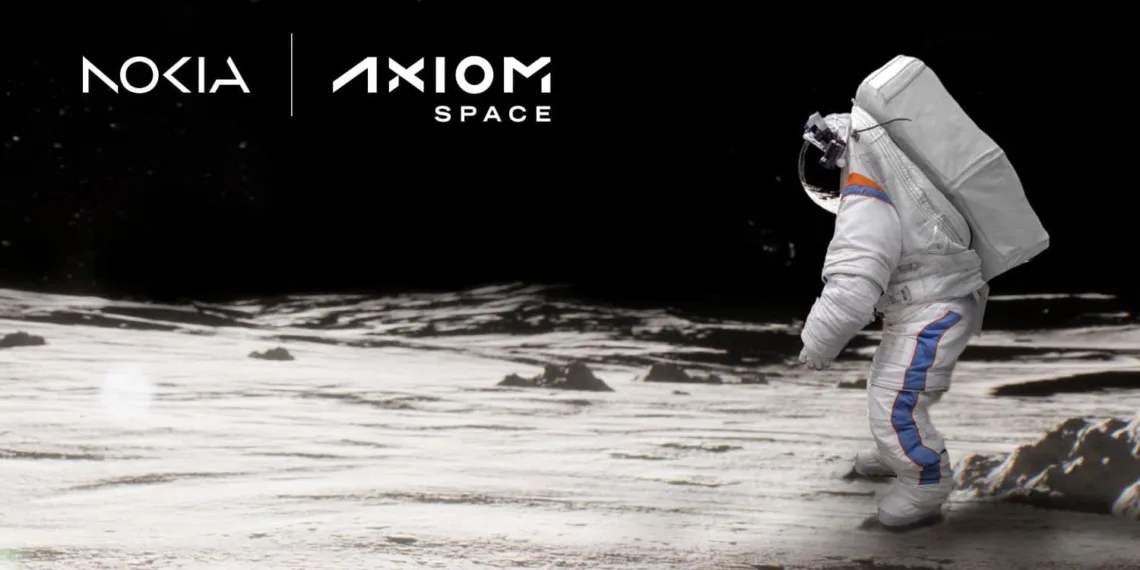In a groundbreaking collaboration, Nokia has partnered with Axiom Space to integrate advanced 4G/LTE communication capabilities into the next-generation spacesuits for the Artemis III lunar mission. This partnership aims to enhance the connectivity and communication abilities of astronauts as they explore the Moon’s surface.
Partnership Details: Nokia and Axiom Space
The collaboration between Nokia and Axiom Space will see the integration of high-speed cellular-network capabilities into the Axiom Extravehicular Mobility Unit (AxEMU). This advanced technology will support HD video, telemetry data, and voice transmission over multiple kilometers on the lunar surface. Artemis III crewmembers will be able to capture real-time video and maintain clear communication with mission controllers on Earth, significantly improving the efficiency and safety of lunar exploration.
Russell Ralston, Axiom Space’s executive vice president of extravehicular activity, emphasized the importance of this partnership: “Axiom Space is excited to work with Nokia to build on the advanced capabilities of our next-generation spacesuit. Adding high-speed 4G/LTE network capability on the Moon will serve as a vital bridge linking astronauts to Earth, facilitating crucial data exchange, and enabling high-definition video communication over long distances.”
Technological Advancements: Nokia’s Lunar Surface Communications System
Nokia plans to deploy the first cellular network on the Moon as part of Intuitive Machines’ IM-2 mission, scheduled for 2024. This mission will demonstrate the potential of cellular connectivity to facilitate crucial communications during future lunar and Mars missions. Nokia’s Lunar Surface Communications System (LSCS), developed by Nokia Bell Labs’ research and innovation, will be deployed during the IM-2 mission and adapted for use in the AxEMU spacesuits.
Thierry E. Klein, President of Bell Labs Solutions Research at Nokia, stated: “Just as astronauts will need life support, shelter, and food, they will need advanced networks to communicate with each other and go about their crucial work. Bell Labs has a long history of working on space projects, and Nokia is a leader in designing and building networks that connect the world.”
The LSCS is fully autonomous and comprises two main components: a network-in-a-box that combines the radio, base station, and core network elements into a single unit, and device modules integrated into the AxEMU spacesuits. Both components are engineered to withstand the extreme conditions of the lunar surface and the dynamic stress of spaceflight, optimized for size, weight, and power consumption.
Future Implications for Space Exploration
Axiom Space’s advanced spacesuits, combined with Nokia’s innovative lunar surface communications technology, mark a significant step forward in space exploration. These next-generation spacesuits will provide astronauts with enhanced capabilities, facilitating NASA’s efforts to access, live, and work on and around the Moon.
The partnership between Nokia and Axiom Space not only advances American leadership in space exploration but also paves the way for a deeper understanding of the Moon, the solar system, and beyond. By incorporating 4G/LTE technology, this collaboration will enable more efficient and effective lunar missions, ultimately contributing to the future of space exploration.
Conclusion
The integration of 4G/LTE capabilities into spacesuits for the Artemis III mission represents a monumental leap in space communication technology. The Nokia 4G/LTE spacesuits, developed in partnership with Axiom Space, will revolutionize how astronauts explore the lunar surface. With enhanced connectivity and real-time communication, this collaboration sets the stage for future innovations in space exploration, ensuring that astronauts are better equipped to carry out their missions and contribute to our understanding of the cosmos.








